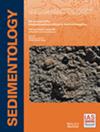Sedimentary dolomite in Western Australia and the dolomite problem: Genesis of channel and playa uranium deposits
IF 2.8
2区 地球科学
Q1 GEOLOGY
引用次数: 0
Abstract
Quaternary to Recent sedimentary dolomite in groundwater calcrete and saltmarsh sediments of Lake Way and Lake Maitland, Western Australia, provide new information about the formation of low‐temperature dolomite. Dolomite can form through numerous pathways depending on the depositional and diagenetic environment. Many pathways involve microbial processes and/or the presence of a nucleation substrate which help overcome kinetic barriers preventing precipitation in the laboratory. Petrographic, mineralogical, hydrogeochemical and stable isotopic data in this study reveal the importance of Mg‐clays as nucleation sites for dolomite precipitation in a range of aquifer environments. There is also a close association between authigenic Mg‐clays, dolomite and the potassium–uranyl–vanadate ore mineral carnotite in channel and playa uranium deposits. It is interpreted that evaporation‐driven precipitation of dolomite establishes a positive feedback loop promoting the dissociation of aqueous uranyl–carbonate complexes and concomitant increase in carnotite saturation. Critical to this model is the presence of authigenic Mg‐clays because they facilitate dolomite precipitation and promote carnotite nucleation by concentrating potassium ions on clay surfaces via adsorption. This Mg‐clay–dolomite–carnotite relationship is widespread throughout Western Australian channel and playa uranium deposits and has been observed in similar deposits in Namibia and Botswana. In addition to this economic implication, Mg‐clay mediated nucleation of dolomite potentially has global relevance as a precipitation mechanism for low temperature dolomite in sedimentary deposits where detrital and/or authigenic Mg‐clays are present. Maturation of sedimentary dolomite from disordered high‐calcian dolomite to ordered low‐calcian dolomite occurs very early in the meteoric realm making it resistant to alteration during burial diagenesis. Diagenetic resistance may be further increased by early meteoric silicification related to the degradation of associated Mg‐clays. These findings indicate that Mg‐clay associated sedimentary dolomite has potential to retain a primary isotopic signature indicative of its origin, making it a useful recorder of palaeoenvironmental conditions.西澳大利亚沉积白云岩和白云岩问题:河槽和洼地铀矿床的成因
西澳大利亚韦湖和麦特兰湖地下水混凝土和盐沼沉积物中的第四纪至近代沉积白云岩提供了有关低温白云岩形成的新信息。根据沉积和成岩环境的不同,白云石可通过多种途径形成。许多途径涉及微生物过程和/或成核基质的存在,这有助于克服阻碍实验室沉淀的动力学障碍。本研究中的岩相学、矿物学、水文地球化学和稳定同位素数据揭示了镁粘土作为一系列含水层环境中白云石沉淀成核场所的重要性。此外,在沟道和洼地铀矿床中,自生镁质粘土、白云石和钾铀钒矿石光卤石之间也存在密切联系。据解释,蒸发驱动的白云石沉淀建立了一个正反馈循环,促进了水铀酰-碳酸盐复合物的解离,同时增加了光卤石的饱和度。这个模型的关键在于自生镁粘土的存在,因为它们通过吸附作用将钾离子集中在粘土表面,从而促进白云石沉淀并促进光卤石成核。这种镁粘土-白云石-光卤石的关系在西澳大利亚的槽形铀矿床和洼地铀矿床中十分普遍,在纳米比亚和博茨瓦纳的类似矿床中也有观察到。除了这种经济意义之外,镁粘土介导的白云石成核作为沉积矿床中低温白云石的一种沉淀机制,具有潜在的全球意义,因为在沉积矿床中存在着脱盐和/或自生镁粘土。沉积白云岩从无序的高钙白云岩到有序的低钙白云岩的成熟过程很早就发生在陨石界,使其在埋藏成因过程中具有抗蚀变性。与相关镁质粘土降解有关的早期陨石硅化可能会进一步增加其抗成因性。这些发现表明,与镁粘土相关的沉积白云岩有可能保留表明其起源的原生同位素特征,使其成为古环境条件的有用记录器。
本文章由计算机程序翻译,如有差异,请以英文原文为准。
求助全文
约1分钟内获得全文
求助全文
来源期刊

Sedimentology
地学-地质学
CiteScore
8.20
自引率
11.40%
发文量
94
审稿时长
6-12 weeks
期刊介绍:
The international leader in its field, Sedimentology publishes ground-breaking research from across the spectrum of sedimentology, sedimentary geology and sedimentary geochemistry.
Areas covered include: experimental and theoretical grain transport; sediment fluxes; modern and ancient sedimentary environments; sequence stratigraphy sediment-organism interaction; palaeosoils; diagenesis; stable isotope geochemistry; environmental sedimentology
 求助内容:
求助内容: 应助结果提醒方式:
应助结果提醒方式:


